
Council on mission to stamp out sea lavender

Share this story
A blitz attack on sea lavender - a pest plant that strangles native species - has brought its eradication one step closer.
Christchurch City Council ecologist Kristina Macdonald led 12 members of the Council’s Parks team and a Forest and Bird volunteer on a search and destroy mission targeting sea lavender plants near the Lower Heathcote River this week.

Council Ecologist Kristina Macdonald helps dig out sea lavender plants near the Lower Heathcote River.
Ms Macdonald said under the new Pest Management Programme the Council was looking at eradicating sea lavender from this site within the next 10 years.
The Heathcote River was the first site in New Zealand where the pest plant was found.
Sea lavender, which has deep tap roots, spreads to form a dense mat in saltmarsh areas. It crowds out existing native plant species preventing them from establishing.
“There used to be thousands of plants here but now that we are down to lower numbers we think eradication might truly be possible,” Ms Macdonald says.
About 650 plants were dug out during Wednesday’s project in the Lower Heathcote River area, the only site in Christchurch city where it has been found. The next closest affected site in in Akaroa which the Department of Conservation controls.
“It’s been there for a while and both staff and volunteers have been controlling it for over 10 years. We thought we’d get a group together and do a grid search and remove what we could find,” Ms Macdonald says.
“It was a very successful effort.”
Residents living in the Lower Heathcote area should check their gardens for this “wee beastie” which will be in flower for the next couple of weeks, she says.
"If they find any plants they should dig them out making sure they get the roots and put them into the Council red rubbish bins."
Forest and Bird own and look after the Calder Green reserve on the Lower Heathcote where sea lavender was first found in the 1980s.
